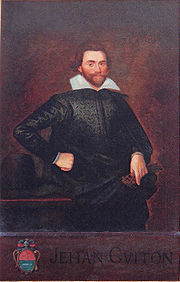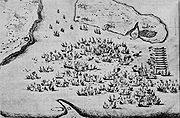
Blockade of La Rochelle
Encyclopedia
The Blockade of La Rochelle (French: Blocus de La Rochelle) took place in 1621-1622 during the repression of the Huguenot rebellion by the French king Louis XIII.
In June 1621, Louis XIII besieged and captured Saint-Jean d'Angély, a strategic city controlling the approaches to the Huguenot stronghold of La Rochelle
. Louis XIII chose however to move south with his main force for the Siege of Montauban
.
to blockade La Rochelle by sea as well as by land. On the sea however, efforts were ineffective, as many small ships could easily go through ships of the Royal Navy and the Huguenot generally had mastery of the sea. At one point they attacked the harbour of Brouage and attempted to block it by sinking ships filled with stones at its entrance.
 In July 1621, d'Epernon
In July 1621, d'Epernon
established his headquarters on land in La Jarrie
, in the vicinity of La Rochelle. In August, the shipowner Jean Guiton
was named by the City Council Admiral of the fleet of La Rochelle, with 16 sails and 90 cannons.
The fleet of La Rochelle under Guiton made at least four sorties against the Royal fleet, commanded by the Count of Soissons, the Duke of Guise, M. de Saint-Luc and Isaac de Razilly
, and somewhat managed to hold its own.
In October, Razilly, leading a French fleet of 13 ships with 124 cannons, stationned seaward in the Pertuis Breton, and Jean Guiton managed to force them to disengage in two encounters on October 6. Jean Guitton then managed to capture the Island of Oléron.
On November 6, Jean Guiton attacked Brouage, where 25 royal ships were stationned, and blocked the entrance of the harbour by sinking ships in it.
The Huguenots met with defeat however when Soubise was vanquished by Royal troops at the Riez marches on 16 April 1622.
By that time the nearby Siege of Royan
was also going on. The blockade of La Rochelle was strengthened under the leadership of the Count of Soissons
. He started the building of the Fort Louis
just outside La Rochelle in order to obtain a commanding position over the approaches to La Rochelle.
 Another major encounter was the Naval battle of Saint-Martin-de-Ré
Another major encounter was the Naval battle of Saint-Martin-de-Ré
in October 1622. As the conflict lengthened into a stalemate however, the King and the Huguenots agreed to the 1622 Treaty of Montpellier
, which maintained Huguenot privileges. Although La Rochelle demanded the destruction of Fort Louis, Louis XIII temporized and managed to maintain it.
This constant threat to the city would be instrumental in encouraging later conflicts, especially the Capture of Ré island
by Royal troops in 1625, and the 1627-1628 Siege of La Rochelle
.
In June 1621, Louis XIII besieged and captured Saint-Jean d'Angély, a strategic city controlling the approaches to the Huguenot stronghold of La Rochelle
La Rochelle
La Rochelle is a city in western France and a seaport on the Bay of Biscay, a part of the Atlantic Ocean. It is the capital of the Charente-Maritime department.The city is connected to the Île de Ré by a bridge completed on 19 May 1988...
. Louis XIII chose however to move south with his main force for the Siege of Montauban
Siege of Montauban
The Siege of Montauban was a siege accomplished by the young French king Louis XIII in 1621, against the Protestant stronghold of Montauban...
.
The blockade
Meanwhile, Louis XIII ordered the Duke of EpernonJean Louis de Nogaret de La Valette
Jean Louis de Nogaret de La Valette , created Duke of Épernon, was a powerful member of the French nobility at the turn of the 17th century. He was deeply involved in plots and politics throughout his life....
to blockade La Rochelle by sea as well as by land. On the sea however, efforts were ineffective, as many small ships could easily go through ships of the Royal Navy and the Huguenot generally had mastery of the sea. At one point they attacked the harbour of Brouage and attempted to block it by sinking ships filled with stones at its entrance.

Jean Louis de Nogaret de La Valette
Jean Louis de Nogaret de La Valette , created Duke of Épernon, was a powerful member of the French nobility at the turn of the 17th century. He was deeply involved in plots and politics throughout his life....
established his headquarters on land in La Jarrie
La Jarrie
La Jarrie is a commune in the Charente-Maritime department in southwestern France.-Geography:The commune consists of the small town La Jarrie and parts of the hamlets Grolleau, Chassagné] and Puyvineux.-Population:-External links:* *...
, in the vicinity of La Rochelle. In August, the shipowner Jean Guiton
Jean Guiton
Jean Guiton was born in La Rochelle where he followed the occupation of ship-owner.Having been nominated Admiral of the fleet of La Rochelle, Jean Guiton fought the Naval battle of Saint-Martin-de-Ré against Royal forces on 27 October 1622....
was named by the City Council Admiral of the fleet of La Rochelle, with 16 sails and 90 cannons.
The fleet of La Rochelle under Guiton made at least four sorties against the Royal fleet, commanded by the Count of Soissons, the Duke of Guise, M. de Saint-Luc and Isaac de Razilly
Isaac de Razilly
Isaac de Razilly was a member of the French nobility appointed a knight of the Order of St. John of Jerusalem at the age of 18. He was born at the Château d'Oiseaumelle in the Province of Touraine, France. A member of the French navy, he served for many years during which he played an important...
, and somewhat managed to hold its own.
In October, Razilly, leading a French fleet of 13 ships with 124 cannons, stationned seaward in the Pertuis Breton, and Jean Guiton managed to force them to disengage in two encounters on October 6. Jean Guitton then managed to capture the Island of Oléron.
On November 6, Jean Guiton attacked Brouage, where 25 royal ships were stationned, and blocked the entrance of the harbour by sinking ships in it.
The Huguenots met with defeat however when Soubise was vanquished by Royal troops at the Riez marches on 16 April 1622.
By that time the nearby Siege of Royan
Siege of Royan
The Siege of Royan was a siege accomplished by the young French king Louis XIII in 1622, against the Protestant stronghold of Royan. This siege followed the Siege of Montauban, in which Louis XIII had failed against the Huguenot city....
was also going on. The blockade of La Rochelle was strengthened under the leadership of the Count of Soissons
Louis de Bourbon, comte de Soissons
Louis de Bourbon, Count of Soissons , was a French nobleman, the son of Charles de Bourbon, Count of Soissons and Anne de Montafié...
. He started the building of the Fort Louis
Fort Louis (La Rochelle)
Fort Louis was a Royal fort built just outside the walls of the Huguenot city in La Rochelle.The fort was a source of great tension between the Huguenots of La Rochelle and Louis XIII, and was perceived as a real threat to their survival...
just outside La Rochelle in order to obtain a commanding position over the approaches to La Rochelle.

Naval battle of Saint-Martin-de-Ré
The Naval battle of Saint-Martin-de-Ré took place on 27 October 1622, between the Huguenot fleet of La Rochelle under Jean Guiton, and a Royal fleet under Charles de Guise....
in October 1622. As the conflict lengthened into a stalemate however, the King and the Huguenots agreed to the 1622 Treaty of Montpellier
Treaty of Montpellier
The Treaty of Montpellier was signed in Montpellier on October 18, 1622 between King Louis XIII of France and Duke Henry II of Rohan. The treaty followed the Siege of Montpellier and ended hostilities between French royalists and the Huguenots...
, which maintained Huguenot privileges. Although La Rochelle demanded the destruction of Fort Louis, Louis XIII temporized and managed to maintain it.
This constant threat to the city would be instrumental in encouraging later conflicts, especially the Capture of Ré island
Capture of Ré island
The Recovery of Ré Island was accomplished by the army of Louis XIII in September 1625, against the troops of the Protestant admiral Soubise and the Huguenot forces of La Rochelle, who had been occupying the Island of Ré since February 1625 as part of the Huguenot rebellions.-Background:The...
by Royal troops in 1625, and the 1627-1628 Siege of La Rochelle
Siege of La Rochelle
The Siege of La Rochelle was a result of a war between the French royal forces of Louis XIII of France and the Huguenots of La Rochelle in 1627-1628...
.

